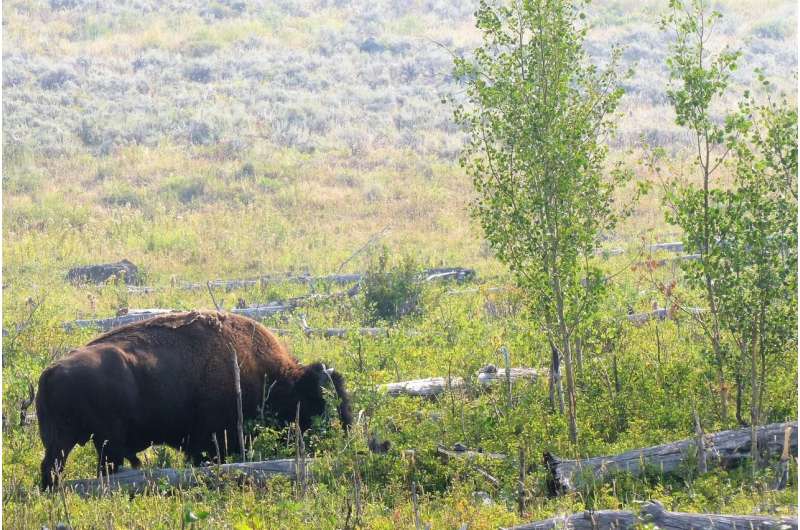This article has been reviewed according to Science X's editorial process and policies. Editors have highlighted the following attributes while ensuring the content's credibility:
fact-checked
peer-reviewed publication
trusted source
proofread
Broken by bison, aspen saplings having a tough time in northern Yellowstone

In northern Yellowstone National Park, saplings of quaking aspen, an ecologically important tree in the American West, are being broken by a historically large bison herd, affecting the comeback of aspen from decades of over-browsing by elk.
Findings of the research led by Luke Painter of Oregon State University were published in Ecology and Evolution.
The study comes five years after Painter, who teaches ecology and conservation in the OSU College of Agricultural Sciences, published a paper in Ecosphere showing that wolf reintroduction in Yellowstone had been a catalyst for aspen recovery both outside and inside park boundaries.
"I've studied the response of aspen in northern Yellowstone to the reduction in elk after the wolves were brought back and found that during this time, bison increased and have begun to affect aspen," Painter said. "Now we're showing strong evidence of a previously unreported behavior of bison bulls breaking aspen saplings."
The saplings were tall enough to escape most browsing by elk and thus likely to grow into trees, but bison broke them off at a low height, he said. Other saplings were killed when bison scraped off the bark with their horns.
Quaking aspen largely reproduces by root sprouts, a process known as suckering, and stands of aspen are often a single organism connected by the trees' common root system. Fire stimulates aspen reproduction from both roots and seeds.
For much of the 20th century, Painter said, aspen sprouts were unable to grow into trees because they were eaten by elk during winter. But at the end of the century, when wolves were reintroduced and the numbers of other large predators such as grizzly bears and cougars increased, elk numbers in the northern part of Yellowstone went down, bringing relief to the aspen.
"Some young aspen began growing into saplings—young trees taller than 2 meters—which was an indication they were no longer being consumed by elk and were likely to grow into mature trees," Painter said. "It was a trophic cascade that changed the Yellowstone ecosystem, creating conditions that could bring it closer to what it was historically, with more aspen, willow and beaver, which depend on these plants. But the tremendous increase in bison over the last two decades has added a new turn to the story."
Bison have long been known to have strong effects on their environment, Painter said. Among those is removing and suppressing shrubs and trees by eating, trampling and breaking them—and as bison numbers have greatly risen in northern Yellowstone in the last two decades, their effects on plants have also increased.
In places where bison are present in large numbers, like Yellowstone's iconic Lamar Valley, they are hindering some aspen stands from replacing their dying trees, he said.
The Yellowstone bison herd is divided into central and northern herds, and this study was in the range of the northern herd. The northern herd's numbers were generally less than 1,000 until 2005 and then increased, for reasons that aren't fully understood, to about 4,000 during the last decade, Painter said.
Painter and OSU College of Forestry collaborators Robert Beschta and William Ripple examined a random sampling of plots in 87 randomly selected aspen stands, and 18% of saplings had been broken. They may resprout from their base, but the sapling height has been lost and new sprouts are vulnerable to being eaten by bison or other herbivores, the researchers note.
Multiple lines of evidence support attributing the breakage to bison, Painter said.
"Most broken saplings were in areas of high bison density and low elk density, and they were broken in summer when elk wouldn't have been foraging on them," he said. "Plus we directly observed bison breaking aspen saplings. The purpose of the behavior doesn't seem to be about accessing food, and we observed only bulls engaging in this behavior, so it may be related to displays of aggression."
Painter noted that Yellowstone bison are managed under an agreement with the state of Montana that requires them to remain in or very near the park—those that stray are killed, captured or hazed back into the park, in large part because they can carry bacteria that cause brucellosis, a threat to Montana's cattle industry.
Elk also carry brucellosis and have passed it to cattle, but the same restrictions are not applied to them. Thus, unlike other wildlife bison are not allowed to disperse to other areas as their numbers and density increase.
The conservation of bison in Yellowstone, whose numbers plummeted nationally from over-hunting in the 1800s, is a big success story, Painter noted—and so is the recovery of aspen and other deciduous woody plants that began when the park's large predators made their comeback.
"Thus, one important conservation goal is affecting another important conservation goal," he said. "Researchers are only beginning to understand how these conservation goals have overlapped and affected each other. We reported a piece of this complex puzzle, describing and quantifying one way that bison shape their habitat by suppressing trees."
More information: Bison alter the northern Yellowstone ecosystem by breaking aspen saplings, Ecology and Evolution (2023). DOI: 10.1002/ece3.10369
Journal information: Ecology and Evolution , Ecosphere
Provided by Oregon State University


















